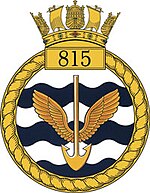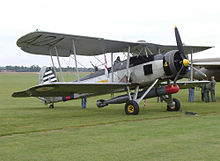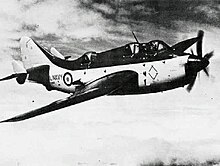
Royal Naval Air Station Yeovilton, commonly referred to as RNAS Yeovilton, is an airbase of the Royal Navy, sited a few miles north of Yeovil, in the English county of Somerset. It is one of two active Fleet Air Arm bases, the other being RNAS Culdrose. RNAS Yeovilton is currently home to the Royal Navy Wildcat HMA2, along with Army Air Corps Wildcat AH1 helicopters, as well as the Royal Navy's Commando Helicopter Force Merlin HCi3/4/4A and Wildcat AH1 helicopters.

The Wildcat Demo Team are the Royal Navy's helicopter aerobatics display team. The team is composed of two AgustaWestland Wildcat HMA.2 anti-submarine (ASW) and anti-surface (ASuW) helicopters, with the aircraft and crews drawn from 825 Naval Air Squadron, based at RNAS Yeovilton , in Somerset.
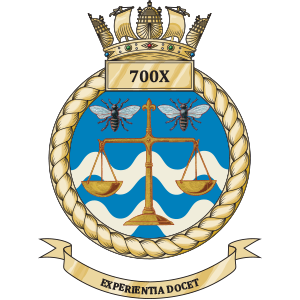
700 Naval Air Squadron is a Fleet Air Arm (FAA) Maritime Unmanned Air System squadron of the United Kingdom’s Royal Navy (RN). Known as 700X Naval Air Squadron, where the 'X' is used to designate 'experimental', it is currently the Royal Navy's Remotely-piloted air systems (RPAS) or 'drone' expert unit.
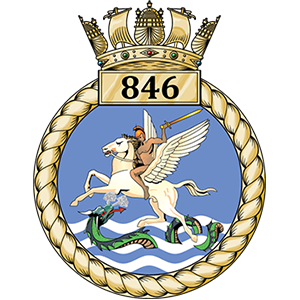
846 Naval Air Squadron is a squadron of the Royal Navy's Fleet Air Arm.

847 Naval Air Squadron is a squadron of the Royal Navy Fleet Air Arm. It operates AgustaWestland Wildcat AH.1 helicopters and provides armed reconnaissance and light transport support to UK Commando Force. Along with 845 and 846 naval air squadrons, it forms part of the Commando Helicopter Force. The squadron was re-formed from 3 Commando Brigade Air Squadron on 1 September 1995.

848 Naval Air Squadron was a squadron of the Royal Navy Fleet Air Arm. It operated the Westland Sea King HC.4 helicopter and previously provided advanced flying training to pilots for the other squadrons in the Commando Helicopter Force. The squadron was based at RNAS Yeovilton in Somerset and was decommissioned on 24 March 2016.

702 Naval Air Squadron was a Fleet Air Arm (FAA) naval air squadron of the United Kingdom’s Royal Navy (RN) which last disbanded in August 2014. It was last based at HMS Heron, RNAS Yeovilton, Somerset and earlier at HMS Osprey, RNAS Portland, Dorset. As a training squadron it trained all ground and air crew for the sister front-line maritime Lynx unit, 815 Naval Air Squadron. It initially formed during July 1936 as a Catapult Flight for the 2nd Battle Squadron based at RAF Mount Batten and routinely embarking in RN ships such as, HMS Nelson, HMS Rodney and HMS Resolution. By 1939 it was known as 702 Naval Air Squadron but disbanded in January 1940.
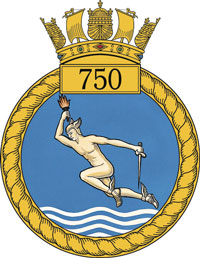
750 Naval Air Squadron is a Fleet Air Arm (FAA) naval air squadron of the United Kingdom’s Royal Navy (RN) which provides training for both Royal Navy Observers and Royal Air Force (RAF) Weapon Systems Officers (WSOs) in managing navigation, communication systems, and weapon control, to enable them to lead operations in Fleet Air Arm helicopters and Royal Air Force Intelligence, Surveillance, Target Acquisition, and Reconnaissance (ISTAR) fixed-wing aircraft.
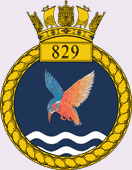
829 Naval Air Squadron was a squadron of the Royal Navy Fleet Air Arm. Before it was decommissioned in March 2018, it operated the AgustaWestland Merlin HM2 helicopter.
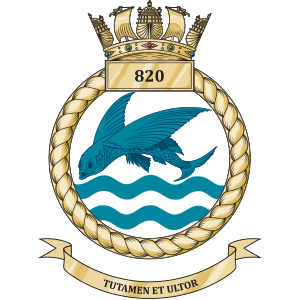
820 Naval Air Squadron is a Royal Navy Fleet Air Arm carrier-based squadron flying the AgustaWestland Merlin HM2 in Anti-Submarine and Airborne Early Warning (AEW) roles from RNAS Culdrose.

814 Naval Air Squadron or 814 NAS, nicknamed the Flying Tigers, is a squadron of the Royal Navy Fleet Air Arm. It is currently equipped with the AgustaWestland Merlin HM2 anti-submarine warfare helicopter and is based at Royal Naval Air Station (RNAS) Culdrose in Cornwall. The squadron was formed in December 1938 and has been disbanded and reformed several times.
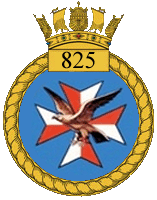
825 Naval Air Squadron is a Royal Navy Fleet Air Arm Naval Air Squadron which was re-commissioned on 10 October 2014 and currently flies the AgustaWestland Wildcat HMA2.

705 Naval Air Squadron is a Fleet Air Arm (FAA) naval air squadron of the United Kingdom’s Royal Navy (RN). It currently forms part of No. 1 Flying Training School at RAF Shawbury and trains pilots and aircrew from all three services under 2 Maritime Air Wing, operating with the Airbus H135 Juno HT Mk1 utility helicopter.

824 Naval Air Squadron is a Royal Navy Fleet Air Arm squadron based at RNAS Culdrose and currently operating the AgustaWestland Merlin HM2 Operational Conversion Unit. It trains aircrew in Anti-Submarine warfare and Airborne Surveillance and Control.

737 Naval Air Squadron was a Fleet Air Arm (FAA) naval air squadron of the United Kingdom’s Royal Navy (RN). It was initially active during 1943 as an amphibious Bomber Reconnaissance Training Squadron. Reactivated in 1944 it operated as an ASV Training Unit until 1945. It was active again between 1949 and 1957. From 1959 it was the Anti-Submarine Warfare school at RNAS Portland. It operated Westland Wessex HAS.3 rescue helicopters from their land base at RNAS Portland, Dorset.

707 Naval Air Squadron was a Fleet Air Arm (FAA) naval air squadron of the United Kingdom’s Royal Navy (RN) which disbanded during February 1995. The unit was operational during the Second World War, having been established in February 1945 under the designation of Radar Trials Unit and subsequently disbanded in October of that year. It was reformed in December 1964 as an Advanced and Operational Flying Training (AFT/OFT) Commando helicopter squadron.

744 Naval Air Squadron is a Fleet Air Arm (FAA) naval air squadron of the United Kingdom’s Royal Navy (RN). It was originally established in 1943 in Nova Scotia and has undergone various re-designations and reformations throughout its history. The squadron has transitioned from early air gunner training to anti-submarine warfare and trials, and in 2018, it reformed at MoD Boscombe Down as the Mission Systems and Armament Test and Evaluation Squadron. Now, in 2024, 744 Naval Air Squadron is taking on the new role of Joint Uncrewed Air System Test and Evaluation Squadron, leading the Ministry of Defence's efforts in UAS testing and evaluation.
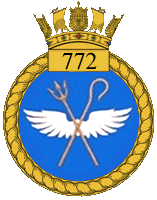
772 Naval Air Squadron was a Fleet Air Arm (FAA) naval air squadron of the United Kingdom’s Royal Navy (RN) which last disbanded during September 1995. 772 Naval Air Squadron formed as a Fleet Requirements Unit out of 'Y' Flight from 771 Naval Air Squadron at RNAS Lee-on-Solent in September 1939. While the headquarters remained there, floatplanes were operated out of RNAS Portland, however, mid 1940 saw the whole squadron move north to RNAS Campbeltown and roughly twelve months afterwards the short distance to RNAS Machrihanish. The unit moved to RNAS Ayr in July 1944 and became the Fleet Requirements Unit School. In January 1946 the squadron moved to RNAS Burscough in Lancashire, before moving to RNAS Anthorn in Cumberland, in May. It became the Northern Fleet Requirements Unit upon moving to RNAS Arbroath, in June 1947, but disbanded into 771 Naval Air Squadron in October. 772 Naval Air Squadron reformed as a Helicopter Support Squadron at RNAS Portland in September 1974. In September 1977 the squadron took over responsibility for a number of Ships' Flights of Royal Fleet Auxiliary ships. The squadron was used to reform 848 Naval Air Squadron for the Falklands Task Force in 1982, with the Ships' Flights absorbed into 847 Naval Air Squadron. In August 1982 it took on the Anti-Submarine Warfare Flight from 737 Naval Air Squadron and between 1983 - 1985 a Search and Rescue Flight operated out of RNAS Lee-on-Solent.

Wildcat Maritime Force (WMF) is a unit of the Royal Navy's Fleet Air Arm. Its primary role is to deploy the AgustaWestland Wildcat HMA2, a battlefield utility, search and rescue, aerial reconnaissance, anti-submarine warfare (ASW), anti-surface warfare (ASuW) and troop transport helicopter, to the frontline. Wildcat Maritime Force is formed of two squadrons, both based at Royal Naval Air Station Yeovilton in Somerset, England, 815 Naval Air Squadron for frontline operations and 825 Naval Air Squadron for engineer training and aircrew conversion.
